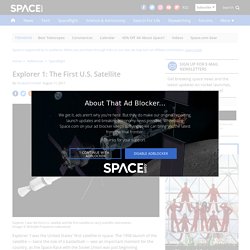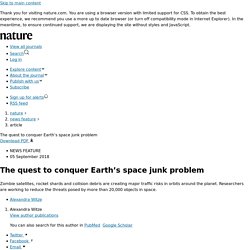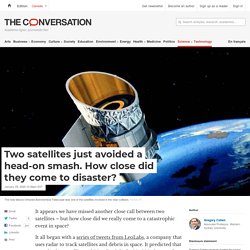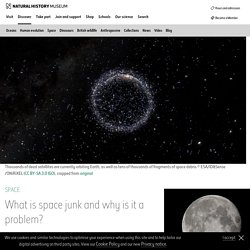

Explorer 1: The First U.S. Satellite. Explorer 1 was the United States' first satellite in space.

The 1958 launch of the satellite — twice the size of a basketball — was an important moment for the country, as the Space Race with the Soviet Union was just beginning. The satellite marked a moment when the United States got its confidence back after a series of unsuccessful launches and the Soviet Union's successful launch of Sputnik. The satellite also helped buttress the nation's technological confidence in the eyes of the world. It signaled that the country was ready to explore the universe.
Spurred by the Soviets Explorer 1's ride to space came through a complicated set of circumstances. The satellite was supposed to launch as the United States' contribution to science during International Geophysical Year (which ran from 1957-1958). This accelerated the United States' plans. Behind the Vanguard Unfortunately, the rocket exploded moments after the launch in front of TV cameras. Explorer 1's science Simplicity and reliability. ClearSpace-1 set to clean up space debris. The European Space Agency has selected EPFL spin-out ClearSpace to lead a space debris de-orbiting project that is planned for launch in 2025.

The ClearSpace-1 mission is being procured as a service contract with a start-up led commercial consortium, to help establish a new market for in-orbit servicing, as well as debris removal. In a statement, Luc Piguet, founder and CEO of ClearSpace said, “This is the right time for such a mission. The space debris issue is more pressing than ever before. Today we have nearly 2000 live satellites in space and more than 3000 failed ones. SSTL and Astroscale team up to tackle space debris. NASA Studies Laser for Removing Space Junk. In 1978, the NASA scientist Donald Kessler predicted that a collision between two pieces of space junk could trigger a cascade of further impacts, creating dangerously large amounts of debris.

Kessler pointed out that when the rate at which debris forms is faster than the rate at which it de-orbits, then the Earth would become surrounded by permanent belts of junk, a scenario now known as the Kessler syndrome. By some estimates, the Kessler syndrome has already become a reality. In January 2009, a collision between the Iridium 33 and Cosmos 2251 satellites created just this kind of cascade.
Two years earlier, the Chinese military tested an anti-satellite weapon by destroying one of its own satellites called Fengyun 1C. Both incidents took place at altitudes of about 800 km. The Aerospace Corporation. That seemingly innocuous little screwdriver litters space, along with gloves, cameras, lens caps, an astronaut blankie, garbage bags, paint flecks, solid fuel, wrenches, nuts, bolts, a tool bag, a pair of pliers, and a toothbrush (don't ask).

The problem is, the above space debris items are nothing compared to what’s also out there: obsolete spacecraft, chunks of satellites and rockets, momentum flywheels, nuclear reactor cores, and fragments of rockets that have broken up or collided with other objects. Simply put—space debris is anything man-made that isn’t in active use. Sizes of space debris range from microscopic particles to obsolete spacecraft and rocket bodies that stand several stories tall.
Protecting the Space Station from Meteoroids and Orbital Debris. Conformal and nonconformal passive shield designs.

Active armor, which uses an internal energy source to deflect incoming objects, is not being considered for use on the ISS. More than 100 different shields have been designed to protect the various critical components of the ISS, although all of the designs are modifications of three ISS primary shielding configurations: the Whipple bumper, the multishock (or stuffed Whipple) shield, and the mesh double-bumper shield. The Whipple bumper, the simplest shield configuration, consists of a single plate of material (typically aluminum), called the bumper, spaced some distance from the underlying module wall (often called a catcher). The role of the bumper is to break up, melt, or vaporize a high-velocity object on impact.
(1) What's the chance that a spacecraft gets hit by debris in a low Earth orbit? The quest to conquer Earth’s space junk problem. On Monday 2 July, the CryoSat-2 spacecraft was orbiting as usual, just over 700 kilometres above Earth’s surface.

But that day, mission controllers at the European Space Agency (ESA) realized they had a problem: a piece of space debris was hurtling uncontrollably towards the €140-million (US$162-million) satellite, which monitors ice on the planet. As engineers tracked the paths of both objects, the chances of a collision slowly increased — forcing mission controllers to take action. On 9 July, ESA fired the thrusters on CryoSat-2 to boost it into a higher orbit. Just 50 minutes later, the debris rocketed past at 4.1 kilometres a second. “There are around 18,000 objects that are currently catalogued.” This kind of manoeuvre is becoming much more common each year, as space around Earth grows increasingly congested. All that traffic can lead to disaster. The alternative, many say, is unthinkable. Dirtying orbits Traffic cops for space The same can’t be said for space debris. Two satellites just avoided a head-on smash. How close did they come to disaster?
It appears we have missed another close call between two satellites – but how close did we really come to a catastrophic event in space?

It all began with a series of tweets from LeoLabs, a company that uses radar to track satellites and debris in space. It predicted that two obsolete satellites orbiting Earth had a 1 in 100 chance of an almost direct head-on collision at 9:39am AEST on 30 January, with potentially devastating consequences. LeoLabs estimated that the satellites could pass within 15-30m of one another. Neither satellite could be controlled or moved. All we could do was watch whatever unfolded above us. Collisions in space can be disastrous and can send high-speed debris in all directions. What is space junk and why is it a problem? As long as humans have been exploring space, we've also been creating a bit of a mess.

Orbiting our planet are thousands of dead satellites, along with bits of debris from all the rockets we've launched over the years. This could pose an issue one day. What is space junk? Space junk, or space debris, is any piece of machinery or debris left by humans in space. It can refer to big objects such as dead satellites that have failed or been left in orbit at the end of their mission. Scientists Propose New Satellite Tech to Dodge Space Junk from Megaconstellations. If a disastrous space junk chain reaction ends up surrounding Earth with a belt of destructive shrapnel, state-of-the-art infrared cameras and gel-based rockets just might help future satellites dodge such debris, a new study finds.

Space debris might not sound dangerous until one realizes that in low Earth orbit — up to about 1,200 miles (2,000 kilometers) in altitude — such debris collides with an average speed of about 22,370 mph (36,000 km/h), according to NASA. At such speeds, even tiny pieces of space debris can inflict devastating damage. Collisions with space debris have already led to millions of dollars in losses. For example, on Feb. 10, 2009, an active U.S. communications satellite called Iridium 33 was obliterated when it was struck by a defunct Russian satellite Cosmos 2251 built in the 1960s.
Meet the Space Custodians: Debris Cleanup Plans Emerge. Over the past 25 years, the amount of space junk orbiting Earth has grown exponentially, and the problem is bound to get worse: Some experts claim the feared Kessler Syndrome, an unstoppable cascade of collisions, is becoming a reality.

The U.S. Space Surveillance Network currently tracks some 18,000 objects larger than 4 inches (10 centimeters), of which only 1,200 are intact, operational satellites. In addition to that, there are 750,000 so-called "flying bullets" about 0.4 inches (1 cm) in size and around 150 million fragments smaller than 1 millimeter. ESA - ESA commissions world’s first space debris removal. ClearSpace-1 will be the first space mission to remove an item of debris from orbit, planned for launch in 2025. The mission is being procured as a service contract with a startup-led commercial consortium, to help establish a new market for in-orbit servicing, as well as debris removal. Following a competitive process, a consortium led by Swiss startup ClearSpace – a spin-off company established by an experienced team of space debris researchers based at Ecole Polytechnique Fédérale de Lausanne (EPFL) research institute – will be invited to submit their final proposal, before starting the project next March.
“This is the right time for such a mission,” says Luc Piguet, founder and CEO of ClearSpace. “The space debris issue is more pressing than ever before. Today we have nearly 2000 live satellites in space and more than 3000 failed ones. “That is the current situation in orbit, and it cannot be allowed to continue. Thank you for liking. Space Debris and Human Spacecraft. More than 500,000 pieces of debris, or “space junk,” are tracked as they orbit the Earth. They all travel at speeds up to 17,500 mph, fast enough for a relatively small piece of orbital debris to damage a satellite or a spacecraft. The rising population of space debris increases the potential danger to all space vehicles, but especially to the International Space Station, space shuttles and other spacecraft with humans aboard. NASA takes the threat of collisions with space debris seriously and has a long-standing set of guidelines on how to deal with each potential collision threat.
These are the countries on Earth with the most junk in space. More than 4,600 satellites orbit Earth, along with more than 14,000 old rocket parts and pieces of space junk.The US is responsible for the most debris in space, followed by Russia and China.Experts worry that not cleaning up space debris could lead to increasing numbers of collisions and a runaway effect that would make it too dangerous to leave Earth. At any given moment, thousands of satellites swarm over our heads at altitudes ranging between a few hundred miles and tens of thousands of miles. But, of the manmade items in space that are larger than your fist, orbiting satellites are a minority. About 95% of what’s out there is space junk: out-of-control space stations, used rocket parts, dead satellites, lost astronaut tools and more.
This dangerous orbital garbage is moving roughly 10 times faster than a speeding bullet and takes a long time to crash back to earth. And it gets worse. Space junk facts and information. In 2009, nearly 500 miles above Siberia, two satellites collided at some 22,300 mph, bursting into a cloud of thousands of pieces of debris. The culprits of this high-speed accident were the inactive Russian satellite Cosmos 2251 and the active U.S. -based communication satellite Iridium 33. Their catastrophic end was the first known time that two satellites collided in space, and a startling reminder of the growing problem of space junk. More than 23,000 known man-made fragments larger than about 4 inches, which is a little wider than two golf balls across, zip around our planet. But those are just the pieces large enough to track.